Origin's Genesis: Flagship Bling
by Dustin Sklavos on April 2, 2011 2:00 PM ESTApplication and Futuremark Performance
We've had the opportunity to take an overclocked Intel Core i7-2600K for a spin before, but Origin's 4.5GHz overclock is the highest we've seen from a boutique system thus far. The Intel 510 series SSD is also very fast and should placate PCMark, so let's see how the Genesis stacks up.
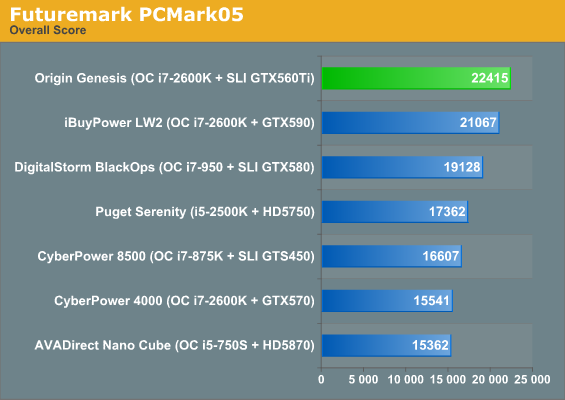
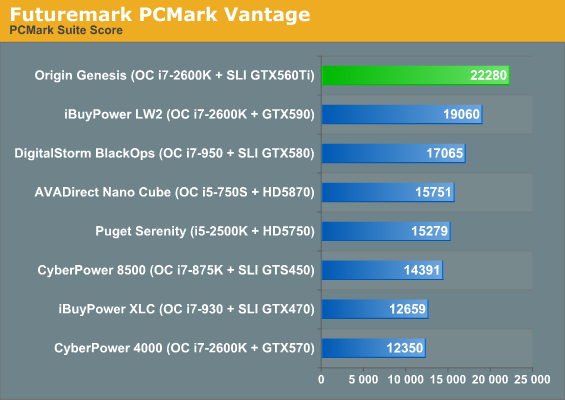
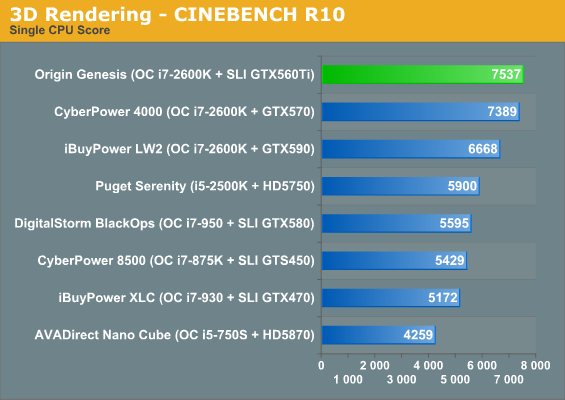
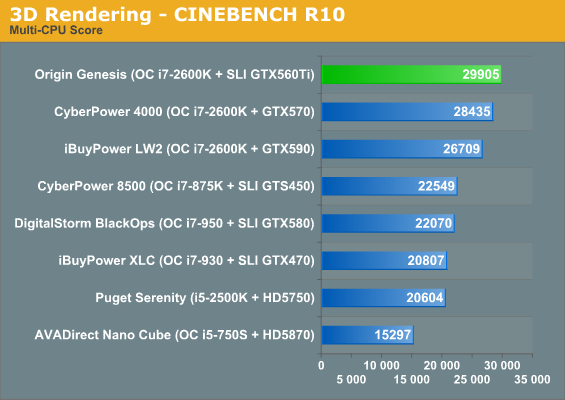
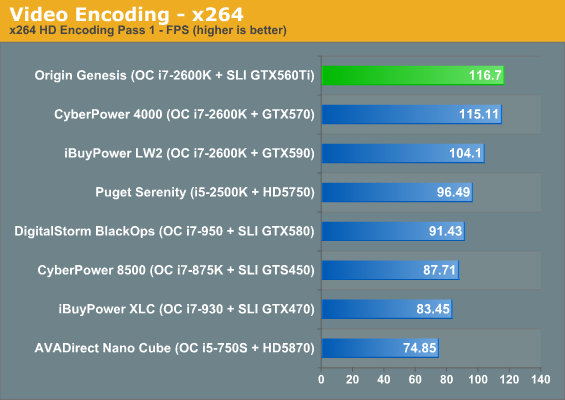
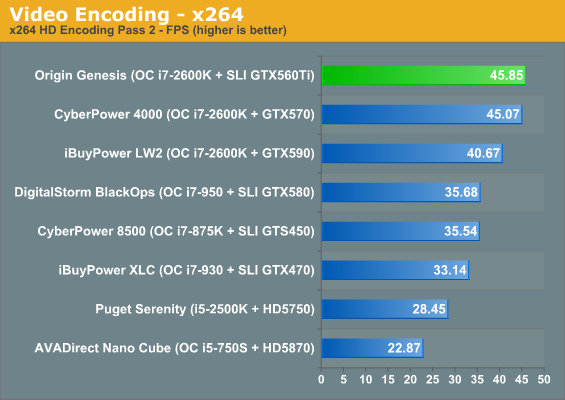
Much to the surprise of no one, the Origin Genesis hangs out at the top of every chart. It boasts the highest overclock on Sandy Bridge (already a performance-per-clock demon) and has among the fastest SSDs on the market along with one of the fastest graphics solutions we've ever tested. The key word, really, is "fast."
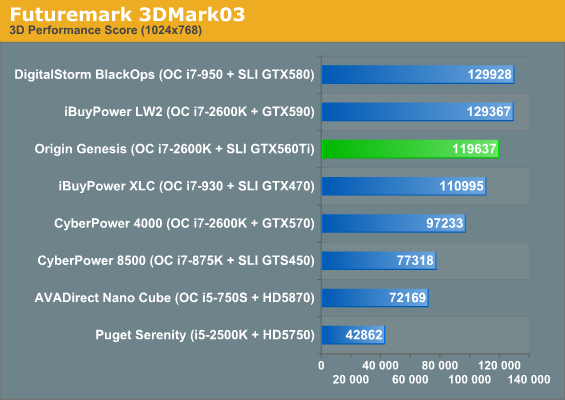

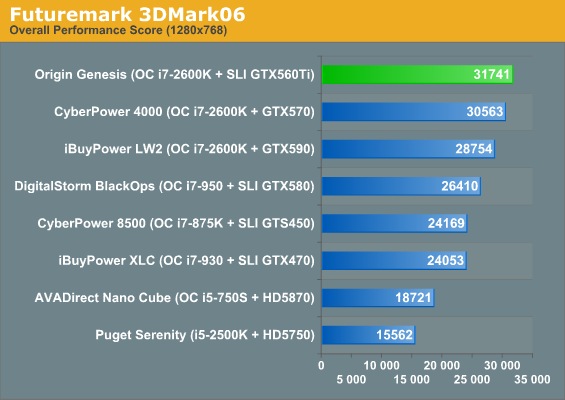
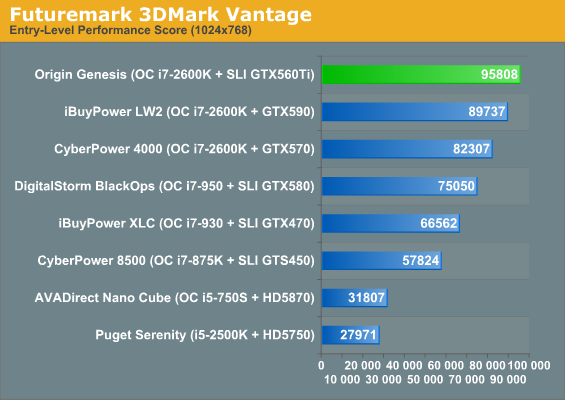
Amusingly, the only 3DMark not tied up in being as heavily CPU-bound is 3DMark03. All of the other tests show the SLI'd GeForce GTX 560 Ti's powering the Origin Genesis beating up on faster graphics solutions. We've been questioning the value of the 3DMark suite for some time, and while it makes for easier comparisons in notebooks, desktop machines are so incredibly fast now that these results are much less useful. What are you supposed to do when an ostensibly independent benchmark is so easily skewed by a single component it's not even expressly designed to test, as is the case when the PCMark scores inflate on account of an SSD or 3DMark gets hung up on processor power?










39 Comments
View All Comments
brucek2 - Saturday, April 2, 2011 - link
Neither of those examples seems so bad to me? If PCMark is supposed to indicate overall PC responsiveness, then seeing a noticeable boost from a SSD seems correct? And we all know its possible for CPU to be the limiting factor in graphic performance depending on the game and graphic settings, especially at low resolutions like 1024x768?
tipoo - Saturday, April 2, 2011 - link
PCmark I somewhat agree with you, but 3D mark is supposed to represent the current gaming situation. Most games now are far more GPU bound than CPU bound, and 3DMark seems to represent that the opposite way.JarredWalton - Sunday, April 3, 2011 - link
The problem with PCMark is that while there are plenty of tasks where an SSD helps, there are also a lot of others where it doesn't do much. Gaming for me feels 99% the same with the game installed to a 1TB HDD vs. a fast SF-1200 SSD. (That's what my current gaming PC is using, incidentally.) Some things are dramatically faster, like installing Adobe Photoshop literally took 1/3 the time vs. an HDD, but while lots of stuff feels snappier there are too many things where an SSD doesn't help for a "system benchmark" to improve by nearly 100%. At least, that's my opinion on the matter.scook9 - Monday, April 4, 2011 - link
The problem is that they are using 3DMark benches that are OLDFor modern systems they should be using 3DMark Vantage at the default Performance settings (1280x1024) and 3DMark 11 at its default performance settings (1280x720) as these are the only settings that anyone will care about and compare to (also only "Official" results for ranking in both hwbot and ORB). Drop 03, 05 and even 06 as they are all notoriously CPU bound (as were the games nearly a decade ago....). Modern drivers also do not optimize for those older programs.
And something I found curious.....if they are so in bed with corsair.....why use a 570LC and not an H70?!
Solidstate89 - Saturday, April 2, 2011 - link
...a Silverstone Fortress FT03 box in the first image on page 1. That is certainly one of the more interesting cases I've seen come out of Silverstone.Rick83 - Saturday, April 2, 2011 - link
Yeah, currently planning my SB build in that (2600K, asus pro board, 2x4GB vengeance 1866 MHz RAM, a 6950 (oh but which?) a Yasya, and a 500W Enermax Modu 87+ (or maybe a seasonic X-FL?) as well as the obligatory slot-in sony optiarc...)Waiting until I can get it for less than a 1000 euros, or an insanely awesome Z68 board sweetens the deal...
Of course, the last review I read insinuated that the fans used in the case are low quality and will have to be replaced. And then there's the question which cooler layout for the graphics will be ideal....
Not quite a done deal yet.
tsekh - Saturday, April 2, 2011 - link
" Even with the Asetek liquid cooler running full bore (and oh how it runs full bore), you'll see temperatures are really quite high compared to other machines. At first it looked like my old nemesis, the Viscount von Lazyoverclocking, was rearing his ugly head, but a quick trip into UEFI revealed a fairly tuned overclock, complete with offset voltage. If anything it just looks like this particular chip needs a healthy amount of voltage pumped into it to hit high speeds;"No. That's definitely lazy overclocking. With Asus P8P67 Deluxe, my 2600k is running stable also at 4.5Ghz with offset voltage +0.03V, and the min/max CPU voltage I get using this setting is 0.984/1.288V. Most 2600k can do this speed at max voltage lower than 1.32V and a lot lower can do it at lower than 1.3V. Comapred to the max CPU voltage of 1.42V, one can expect at least 10C degree difference in load temperature, given a non-rubbish cooling system.
LtGoonRush - Saturday, April 2, 2011 - link
"given a non-rubbish cooling system." That right there is the problem, commercial water cooling products simply aren't even remotely competitive with air coolers. I've been harping on this for a long time, but it's true: water cooling is obsolete in the face of heatpipes, which provide better cooling, lower costs, lower noise, and higher reliability. This build uses the Asetek OEM version of the Corsair H70, for nearly $30 less a Thermalright Silver Arrow would have provided far better cooling with fans running at <1200rpm, and you don't have to worry about a pump potentially failing.The_Assimilator - Saturday, April 2, 2011 - link
@tsekhIf you know anything about overclocking then you'll know that not all CPUs are created equal. Just because you got a chips that clocks well doesn't mean Origin did. I've personally seen a 2600K that refuses to exceed 4.2GHz regardless of the volts/cooling applied.
@LtGoonRush
"commercial water cooling products simply aren't even remotely competitive with air coolers"
Wrong. I replaced a TRUE 120 with an H50 (using the same fans) and the H50 is cooler. Maybe if you're comparing commercial watercoolers to high-end aircoolers that statement is valid, but then the comparison isn't.
"a Thermalright Silver Arrow would have provided far better cooling with fans running at <1200rpm"
Except that the Silver Arrow is absolutely huge and monstrously heavy, which means that shipping it pre-installed is a bad idea, which makes it a non-option for a boutique PC that's going to be transported who knows how far.
tsekh - Saturday, April 2, 2011 - link
@ The_AssimilatorIf you know anything about overclocking then you should know there is a humongous difference 1.28V and 1.42V. If that particular 2600k can't OC to 4.5Ghz, it just can't and that's very rare. But if it can do 4.5Ghz, it definitely can do it at much lower voltage. 1.42V is simply a huge overkill. Also, you have to be either extremely unlucky, or simply a complete idiot, to fail to OC a 2600k past 4.2Ghz. Most people can do 4.2Ghz with everything on auto with their P67 motherboards. I hope it has to do with your bad luck.